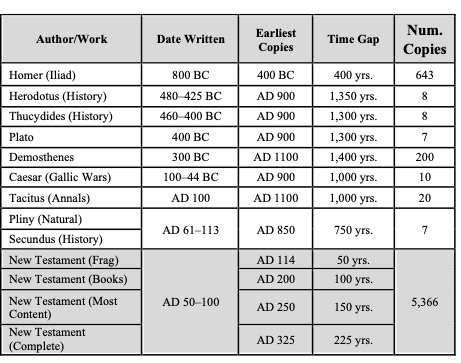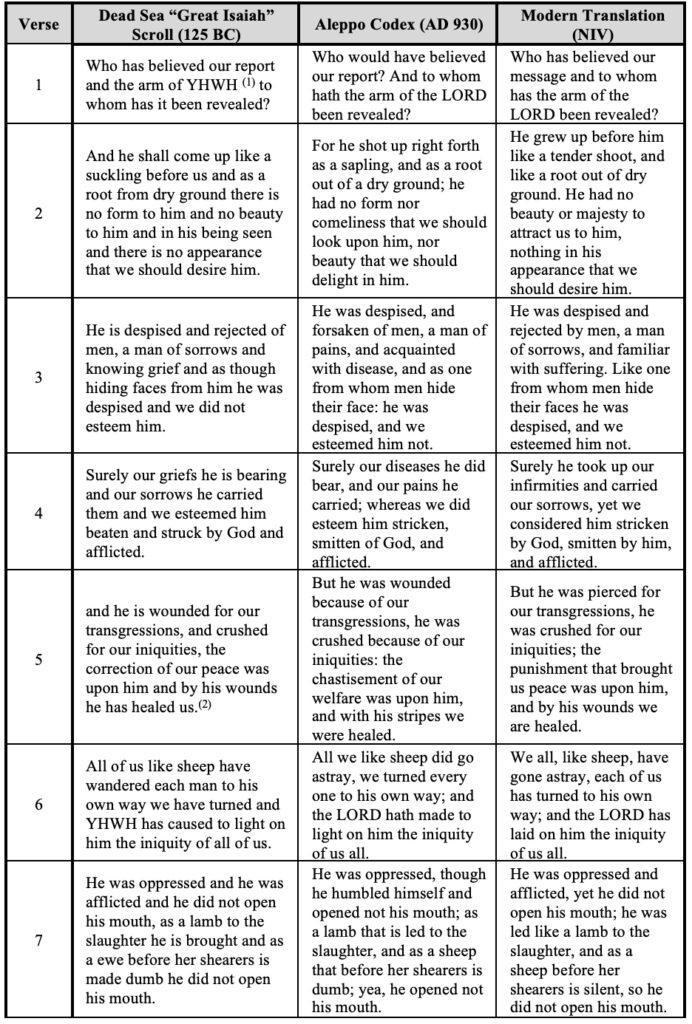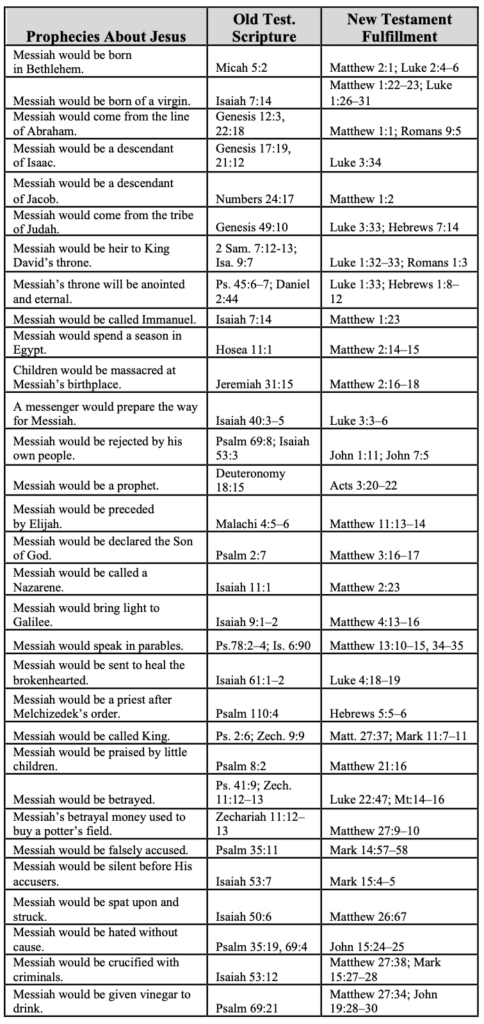Inerrancy refers to God’s original Word having no errors. Inerrancy is important because the question of ultimate authority is of the highest importance to the Christian. It’s not just a theological or philosophical issue—it’s one that permeates our lives, thoughts, attitudes, perspective, and ultimately our behaviors.
We can’t offer the world a reliable gospel if it comes from an unreliable Scripture. How can we offer the truth on any issue if we’re suspicious of errors everywhere? For example, airline pilots will ground their planes even with the most minor of faults, knowing that one flaw can destroy confidence in the whole machine. If you pick your car up after being serviced and find out they missed something simple, wouldn’t that call into question the rest of their work?
The entire core message of the Gospel, including sin, redemption, and forgiveness, is rooted in Genesis history. If these core events are not true, how can we trust the theology behind them? Did Jesus die for the sins of a mythical Adam who lived in a mythical garden?
The Bible itself claims to be much more than myth—it claims to be God’s Word delivered through human authors to all humankind. Passages like 2 Peter 1:21 and 2 Timothy 3:16 assure us that God Himself authored the Scriptures. The process by which God produced the Scriptures is sometimes called the inspiration of Scripture, because 2 Timothy 3:16 says that, “All Scripture is given by the inspiration of God” (emphasis added). The Greek word translated “given by the inspiration of God” is theopneustos, literally, “God-breathed.” God “breathed out” the Words of the Bible! Because of this, everything it says is completely reliable, making it the only sure foundation for the Christian in all matters of faith and life (2 Timothy 3:17). Psalms 119:89 also makes clear that God’s Word is “fixed” or “settled” in Heaven.
Jesus confirms this by saying that not even a dot on a letter will pass away from God’s Word until heaven and earth pass away. He also prayed to the Father saying, “Sanctify them by Your truth. Your word is truth.” Jesus also confirmed that Moses produced the Torah, rather than it being a compilation of Ancient Near East mythology as some colleges teach today. Jesus referred to the Old Testament over 40 times and every time He treated it as real history, including Creation, the Flood, Sodom and Gomorrah, Jonah and the fish, and the account of Cain and Abel. To Jesus, the Bible was clearly inerrant, inspired, and historical.
The New Testament writers were so convinced that the writings of the Old Testament were the actual words of God that they even claimed “Scripture says” when the words quoted actually came directly from God. In Romans 9, Paul accepted that God delivered His Word directly to Moses. Paul also treats Isaiah’s words as God Himself speaking.¹ In Acts 4, both Peter and John affirmed the creation account in the 4th commandment written by God. The believers who heard Peter and John also acknowledged that David wrote Psalm 2 by the Holy Spirit.
Having established that Scripture teaches that it is God’s authoritative Word, let us now consider some of the ways we can evaluate the validity of the Scriptures. First, we will look at the New Testament.
There are some classic historical tests we can use to demonstrate the validity of the New Testament writings: First, we can determine whether what we have today matches what was written originally. Second, we can evaluate whether the recorded events describe true, historical events. Let’s see how the Bible holds up to each of these tests.
Putting the Reliability of Scripture to the Test
One way to apply the first test is to look at the time gap between the original writing and the copies that still exist today. Ancient manuscripts like the New Testament were written on fragile material such as papyrus.² This required ancient writers to continually make new copies. Copying documents by hand is a time-consuming, laborious task, and understandably, errors sometimes creep into copies. Over time, as copies are made of copies, deviations from the original text due to copying errors can accumulate. However, the closer the copy is to the original, the greater chances that it more accurately represents the original.
For example, in 1946 the Dead Sea Scrolls were discovered, which included over 900 manuscripts dating from 408 BC to AD 318. These manuscripts were written mostly on parchment (made of animal hide) but with some written on papyrus. Because these materials are fragile, they have to be kept behind special glass in climate-controlled areas.

Table 2. How the New Testament Compares to Other Ancient Writings³
Table 2 reveals two important facts. First, when we evaluate the number of New Testament manuscripts we have compared to other famous works of antiquity, the Bible exceeds them all with 5,366 manuscripts!⁴ Adding the copies from other languages (such as Latin, Ethiopic, and Slavic) results in more than 25,000 manuscripts that pre-date the 15th century printing press! By comparison, the runner-up historical text (Homer’s Iliad) has only 643.⁵ Having more copies means that we can have greater certainty that the words of the New Testament have been preserved accurately because we can compare copies with one another and correct for copying mistakes. Second, we can also see that the time span between the original and these copies is closer than any other work compared. There is more.
Even if all the copies of the Bible from AD 350 to today were destroyed, the entire New Testament (except for only 11 verses)⁶ could be reconstructed using only quotations by the Early Church Fathers in the first few hundred years after Christ! This is because the Church Fathers frequently quoted large sections of Scripture in their letters to each other.
Next, we can test to see if what was written down actually happened. The gospels written by Matthew, Mark, and John were written with or by direct eyewitnesses of the events in Jesus’ life. Luke, a physician, wrote the account of Jesus’ life for Theophilus, a high-ranking official.⁷ Luke said: “Many have undertaken to draw up an account of the things that have been fulfilled among us, just as they were handed down to us by those who from the first were eyewitnesses and servants of the word.” Luke continues to state that he carefully vetted his account of Jesus’ life and ministry: “With this in mind, since I myself have carefully investigated everything from the beginning, I too decided to write an orderly account for you, most excellent Theophilus, so that you may know the certainty of the things you have been taught.”
Other New Testament writers had similar testimonies: First John 1:3 states: “We proclaim to you what we have seen and heard, so that you also may have fellowship with us…” Second Peter 1:16 says: “For we did not follow cleverly devised stories when we told you about the coming of our Lord Jesus Christ in power, but we were eyewitnesses of His majesty.”
We should also consider that 11 of the 12 disciples died terrible deaths—being killed for their unchanging testimony of who Christ was—and of His resurrection. They were so sure that Christ was who He claimed to be that they signed their testimonies with their own blood! Who would die for a resurrection that never happened? Paul said that without the resurrection, “we are of all men the most pitiable,” if indeed they suffered persecution for a falsehood.
It’s also incredible that numerous Bible prophecies have come true over the years—even prophecies that we now can confirm were written before the actual events occurred. For example, Isaiah 53 specifically foretold Christ’s trial, crucifixion, and burial.
Isaiah 53 and the Dead Sea Scrolls
In 1947, shepherds chasing a lost sheep in the caves above the Qumran Valley northwest of the Dead Sea made one of the most significant archaeological discoveries of our time—the Dead Sea Scrolls. Over 900 scrolls were found in numerous clay jars, and 200 of the scrolls include numerous sections and fragments of every book in the Old Testament except Esther.
One of the most significant scrolls is called the “Great Isaiah Scroll,” which includes the same Book of Isaiah that we have today in modern bibles but dates to 125 BC.⁸ The Isaiah Scroll is significant for two reasons: (1) it was written before Christ was yet born, and it includes Chapter 53 which contains clear prophecies about the torture, death, burial, and resurrection of Christ; and (2) its discovery now allows us to compare three versions of the Bible representing different time periods: Pre-Christ Dead Sea Scroll, AD 930, and today. Table 3 provides a word-by-word comparison of these three versions so you can see for yourself how reliable the transmission process has been through the millennia:

Table 3. Comparison of Isaiah 53 between the Dead Sea Scrolls, the Aleppo Codex, and the Modern Bible.⁹
While variation exists between versions due to translational differences, Table 3 shows that scribes maintained an incredibly high degree of similarity between copies over millennia. In fact, regarding this specific chapter in Isaiah, renowned Christian philosopher and apologist Norman Geisler writes:
Of the 166 words in Isaiah 53, there are only 17 letters in question. Ten of these letters are simply a matter of spelling, which does not affect the sense. Four more letters are minor stylistic changes, such as conjunctions. The remaining three letters comprise the word “light” which is added in verse 11, and does not affect the meaning greatly. Furthermore, this word is supported by the Septuagint and IQ Is [first cave of Qumran, Isaiah scroll]. Thus, in one chapter of 166 words, there is only one word (three letters) in question after a thousand years of transmission—and this word does not significantly change the meaning of the passage.¹⁰
How is this possible? How can these three different documents—being translated and transcribed over a 2,000-year timeframe—have such incredible similarity? One explanation is simply that God watched over the process. Practically speaking, He used many incredible scribes to do it. For example, the Talmudists (Hebrew scribes and scholars between AD 100 and AD 500) had an incredibly rigorous system for transcribing biblical scrolls. Samuel Davidson describes some of the disciplines of the Talmudists in regard to the Scriptures:¹¹
A synagogue roll must be written on the skins of clean animals, prepared for the particular use of the synagogue by a Jew. These must be fastened together with strings taken from clean animals. Every skin must contain a certain number of columns, equal throughout the entire codex. The length of each column must not extend over less than 48 or more than 60 lines; And the breadth must consist of thirty letters. The whole copy must be first-lined; And if three words be written without a line, it is worthless. The ink should be black, neither red, green, nor any other color, and be prepared according to a definite recipe. An authentic copy must be the exemplar, from which the transcriber ought not in the least deviate. No word or letter, not even a yod, must be written from memory, the scribe not having looked at the codex before him… Between every consonant the space of a hair or thread must intervene; Between every new parashah, or section, the breadth of nine consonants; Between every book, three lines. The fifth book of Moses must terminate exactly with a line; But the rest need not do so. Besides this, the copyist must sit in full Jewish dress, wash his whole body, not begin to write the name of God with a pen newly dipped in ink, and should a king address him while writing that name, he must take no notice of him.
Why is Isaiah 53 so important to Christians? It’s important because Isaiah 53 includes at least 12 highly specific prophecies regarding the life, death, and resurrection of Christ. The details in this chapter would not be nearly as important if they were written after Christ’s birth, but the fact that we can confirm that the chapter was in fact written before Christ proves beyond reasonable doubt both the accuracy and Divine authorship of the Bible. Consider these 12 prophecies, originally written by Isaiah about 700 years before Christ was even born, alongside references of their New Testament fulfillments:¹²
- He would not be widely believed (John 1:10–12).
- He would not have the look of Majesty (Luke 2:7).
- He would be despised and suffer (Matthew 26:67–68; 27:39–43).
- He would be concerned about health needs (Matthew 8:17) and would die for our sins (1 Peter 2:24).
- His pain/punishment would be for us (Matthew 28:20; Romans 4:25).
- He would not respond to charges (Matthew 26:63).
- He was to be oppressed and killed (Matthew 26:65–68).
- He was associated with criminals during life and at death (Matthew 27:38, 27:57–60).
- He would be buried in a rich man’s tomb (Isaiah 53:9).
- He would be crushed, suffer, and die, yet live (Luke 23:44–48, 24:36–44).
- He would bear our sins (1 Peter 2:24).
- He would have a portion with the great (Philippians 2:8–11).
Now that we have the Dead Sea Scrolls, we can confirm that these prophecies were written before Christ even walked the earth! How could anyone fulfill each of these prophecies, many of which happened after Christ’s death and were clearly out of His control (i.e., if He wasn’t God)? Finally, consider these prophecies about Christ that were all penned before He was born, and their fulfillments:¹³
Summary
These are some of the reasons why tens of thousands of ministry professionals have signed the Bible Petition, affirming that the Bible alone, and in its entirety, is the infallible written Word of God in the original text and is, therefore, inerrant in all that it affirms or denies on whatever topic it addresses.
This leaves us at a crossroads: either the Bible is divinely inspired and true in all it says including historical events, or it is not. It can’t be true and untrue at the same time. What gives us the right to pick and choose which parts we want to believe? If the Bible is not based in real history but claims to be historical, it’s not authoritative, and if it’s not authoritative, why follow and obey it? If it is not true, then there’s no reason to submit to it. Since the Bible is true, however, it has authority over all matters of life.
When Christians understand that the Scripture is inerrant and historically valid, their faith and their minds are fused together—like two pieces of a puzzle. This provides a solid foundation for their faith in the work of Christ as revealed in the Words of Christ, resulting in a solid foundation for their faith, a real faith that produces good fruit.
Footnotes
- Verse 15 and 17 respectively. Also acts 28:25.
- For example, in 1946 the Dead Sea Scrolls were discovered, which included over 900 manuscripts dating from 408 BC to AD 318. These manuscripts were written mostly on parchment (made of animal hide) but with some written on papyrus. Because these materials are fragile, they have to be kept behind special glass in climate-controlled areas.
- Josh McDowell, The New Evidence that Demands a Verdict. Nashville: Thomas Nelson Publishers, 1999, 38.
- The number is actually higher now, at about 5,801 manuscripts (see: John Piper, A Peculiar Glory: How the Christian Scriptures Reveal Their Complete Truthfulness. Wheaton, IL: Crossway, 2016).
- McDowell, The New Evidence that Demands a Verdict, 38.
- Most of the 11 verses come from 3 John: Geisler & Nix, A General Introduction to the Bible. Chicago: Moody Press, 1986, 430.
- Theophilus ben Ananus was the High Priest in Jerusalem from AD 37 to 41 and was one of the wealthiest and most influential Jewish families in Iudaea Province during the 1st century. He was also the brother-in-law of Joseph Caiaphas, the High Priest before whom Jesus appeared. See Wikipedia and Cooper, B. The Authenticity of the Book of Genesis. Portsmouth, UK: Creation Science Movement, 2012.
- The Digital Dead Sea Scrolls Online, Directory of Qumran Dead Sea Scroll: http://dss.collections.imj.org.il/isaiah (September 1, 2019).
- Source for DSS: Fred Mille, “Qumran Great Isaiah Scroll,” Great Isaiah Scroll: http://www.moellerhaus.com/qumdir.htm; Source for Aleppo Codes JPS: “Mechon Mamre” (Hebrew for Mamre Institute):http://www.mechon-mamre.org/p/pt/pt1053.htm. (December 10, 2013).
- Geisler & Nix. A General Introduction to the Bible.
- Samuel Davidson, Hebrew Text of the Old Testament, 2d ed. (London: Samuel Bagster & Sons, 1859), 89.
- Mary Fairchild, “44 Prophecies of the Messiah Fulfilled in Jesus Christ,” About.com: www.christianity.about.com/od/biblefactsandlists/a/Prophecies-Jesus.htm. (December 18, 2013).
- See website: https://defendinginerrancy.com/

